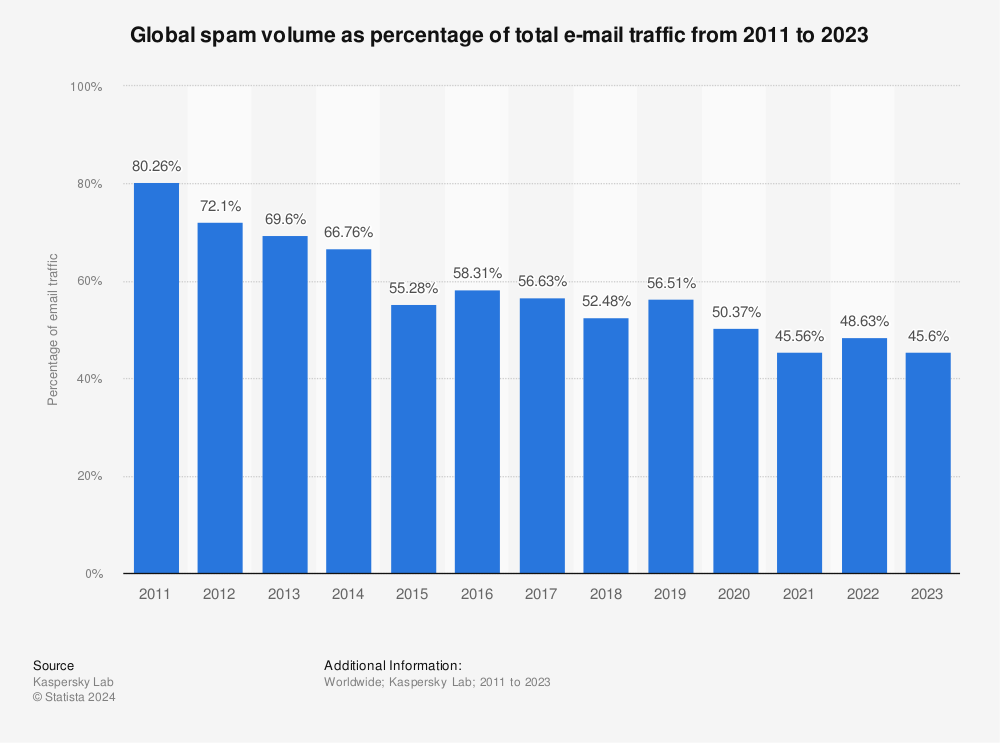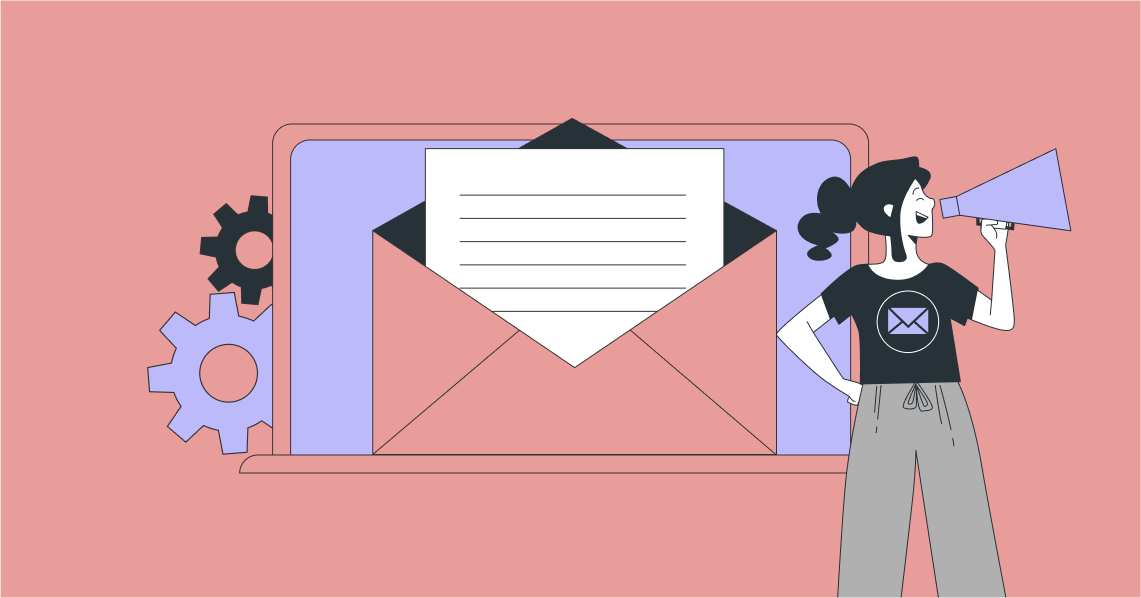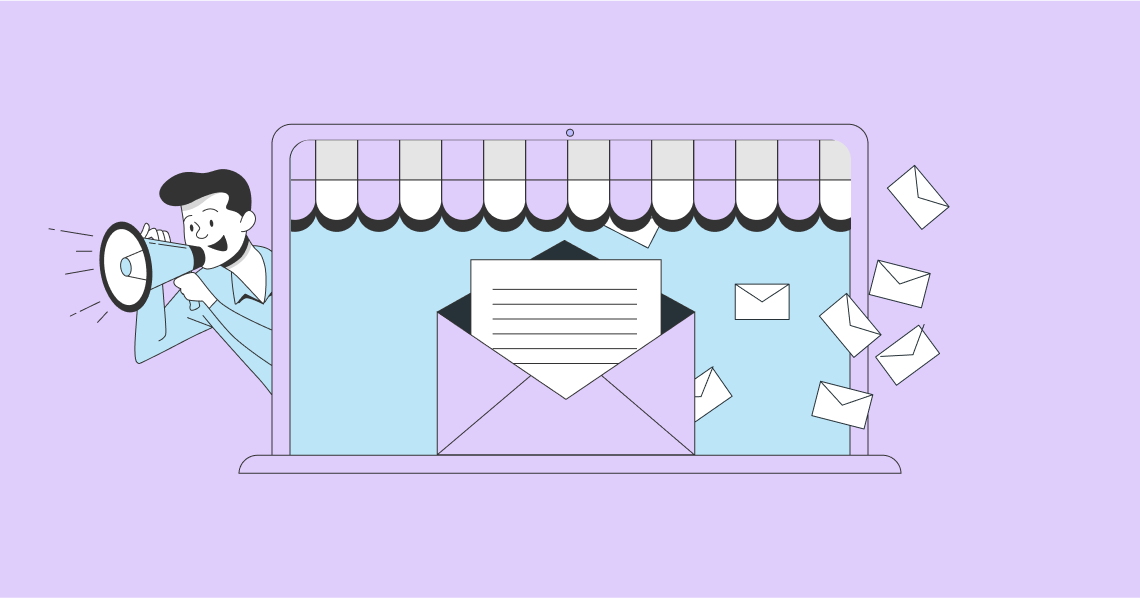The B2B industry is quite different from other sectors. One of the biggest differences is that the buyer’s journey is typically longer. B2B buyers will read multiple content pieces before they’re ready to make a purchase. As such, B2B businesses need to nurture their target audience more.
Email marketing can be a very effective way to share various types of content pieces and nurture subscribers. Plus, as the B2B industry has come to realize that it’s time to focus less on in-person and virtual events and more on digital forms of marketing, like email, the next few years will be critical for your email marketing campaigns.
To help you craft an effective B2B email marketing strategy, here are over 20 valuable stats to keep in mind. And, to make sure you realize just how big email marketing is, we first start off with a couple of general email marketing statistics before exploring how it applies to B2B organizations and their marketing teams.
General B2B Email Marketing Statistics
1. There will be nearly 5 billion email users by 2025
According to information shared by Statista, it’s anticipated that there will be about 4.6 billion email users in 2025. To put this growth into better perspective, in 2020, the number of email users across the world was estimated at 4 billion.

Number of email users worldwide
2. More than 370 billion B2B Marketing Emails will be sent per day by 2025
In 2020, Statista reported that more or less 306 billion emails were sent (and received) each day across the world. This number is expected to increase by more than 70 billion in the next few years to exceed 376 billion daily emails by 2025.
In 2023, the number of emails sent and received each day across the world is estimated to add up to 347.3 billion. It will then continue to increase slowly just like it has done since 2017.
3. Email marketing revenue is set to reach nearly $14 billion by 2025
Since 2020, email marketing revenue has increased steadily. It’s anticipated that by 2025 it will reach $13.69 billion. To put this growth into perspective, in 2020, it was merely $7.5 billion.
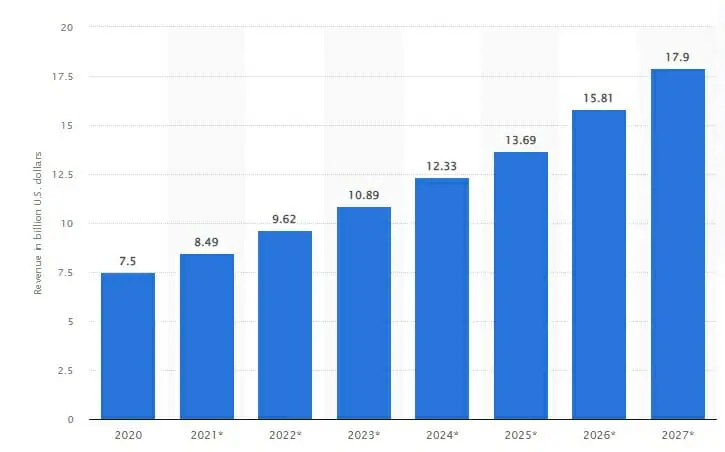
Email marketing revenue worldwide
4. Consumers typically have more than one email account
According to an email statistics report shared by The Radicati Group, a technology market research firm, consumer email accounts drive the most growth. They estimated that in 2022, the email accounts per user ratio were 1.86 accounts per user.
The reason for this is that some consumers prefer to have separate email accounts for different purposes. For example, they’ll have a dedicated email account just for shopping, and another one for social interactions.
5. Consumers want to be contacted by email (only by specific brands)
If you're reluctant to send emails to your subscribers or leads because you're afraid of being seen as spam, you may want to reconsider. According to this research, 86% of customers want to hear from businesses they buy from frequently, and 60% of consumers said that email is their preferred method.
So, if you want to tell your subscribers about a new product or remind them of an upcoming sale, email is the way to go. However, this isn't a free pass to send as many emails as you want. It's best to send around 2 to 3 weeks per week. Only send more if it's necessary, like during a special promotion or event.
Incorporate our email marketing tips in your campaigns to increase open rates.
6. Most people check their inboxes 3 to 5 times a day
Many businesses think that their emails will get lost in the clutter of their subscribers' inboxes, but that's not always the case. In fact, 39% of responders to a survey said they check their inboxes 3 to 5 times a day. So they're likely to see your email.
You might think people are checking their email just for work and not to get brand communication. While that's true to some extent, 40% of respondents actually check their emails to look for discounts from brands they do business with.
However, if you want your emails to get opened, you must make them relevant. In the same study, 47% of people said that the primary reason they open all emails from a brand is because of relevance. So, make sure your subject line and content are personalized to what the recipients are interested in.
7. Over 65% of marketers use email to communicate with customers and prospects
It's evident that marketers are aware of the consumers' preference for email communications because 66% of marketers use corporate email to interact with prospects and customers. Social media is in second place, with 11% of marketers using it. Some other channels marketers use are phone, face-to-face, and instant messaging.

How marketers interact with customers
Email is the first choice because of its formality. It's also less intrusive than a phone call and less time-consuming than face-to-face meetings. Plus, it allows marketers to track and measure their campaign's success through email metrics like open rates and click-through rates.
8. Half the US B2B marketers find email marketing to be the most impactful
B2B marketers use email marketing more than any other tactic because it's the most effective. In an eMarketer survey, 50% of B2B marketers in the US said that they find email marketing to be most impactful for their multichannel strategy.
Social media was deemed effective by 33% of marketers, while 26% opted for content marketing. Digital advertising, partnerships, public relations, and account-based marketing were also mentioned as impactful tactics.

Most impactful marketing channel
In another report, 62% of B2B and B2C marketers said that they have increased their marketing budget in email marketing in the past 12 months. The budget increment was the highest among other marketing tactics, including social media, influencer marketing, digital audio, direct mail, and printed media.
With more budget, marketers can spend more on relevant email marketing trends, such as personalization, automation, and segmentation. It also allows them to invest in tools that can improve email marketing performance.
B2B Email Open Rate Statistics
9. The average email deliverability rate is just below 85%
A recent blog post published by Email Tool Tester found that the average deliverability for all email tools combined was just below 85%. The other 15% of the emails sent were either flagged by spam filters or vanished into the abyss.
10. The average open rate across industries is over 35%
According to Mailchimp's report, the average open rate across all industries is over 35%. That means that for every 100 emails sent, at least 35 of them are opened by the recipients. The average click-through rate is 2.6%, which means of those 35 opened emails, roughly one will result in a click. These rates may seem low, but they are actually higher than other digital marketing tactics, such as display advertising.
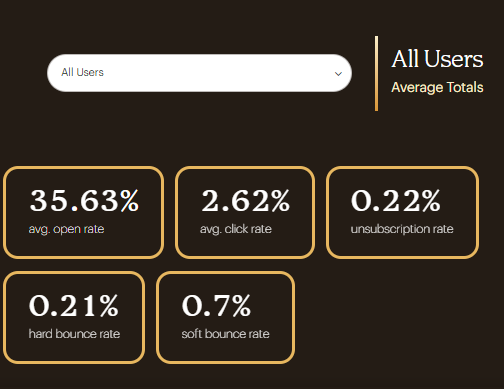
Average open rates across industries
The open rate is slightly lower for mobile devices compared to desktops. Mailchimp's data shows that the open rate for mobiles is about 31%, while the click-through rate is 1.5%.
Similarly, some industries have a higher open rate than others. For example, the average open rate for eCommerce businesses is almost 30%, while beauty and personal care businesses enjoy up to 32% open rate.
11. Image-based emails have a higher open rate than text-based emails
If you want your emails to be read, add an image or graphic to them. Get Response data shows that emails with images have a higher click-through rate than those without. According to this report, emails with graphics have an open rate of over 43%. The click-through rate is also high at 4.85.
On the other hand, text-only emails have an open rate of 35.75, while the click-through rate is just 1.6%. There's not much of a difference in the bounce rate of both types of emails since those with images only have a slightly higher bounce rate of 2.4% compared to text-only emails with a bounce rate of 2.3%.
These findings show the importance of visuals in email marketing. For example, you can include product images in your promotional emails to entice readers to click through and make a purchase. For informational emails, add infographics and charts.
12. Certain words increase the open rate of an email
The Get Response report from above also found that certain phrases, when added to email subject lines, can increase the open rate. For example, words like ''now'' and ''invitation'' have higher open rates. You can also add the name of a month, as this adds a sense of urgency to your email.
For example, instead of using a subject line like ''New products now available'', you can try ''Hurry! New products for June just arrived!''. The latter can increase open rates.
The report also found that some phrases not only increase open rates but also click-through rates. These include ''newsletter'' and ''affordable.'' You can also use several words to lower your unsubscribe rates. For example, ''guaranteed,'' ''PDF,'' and ''bargain'' were found to reduce unsubscribe rates and maintain subscriber satisfaction.
So, it's imperative to write a catchy and relevant subject line to increase the chances of your email being opened and read. We recommend using an email subject line tester tool to evaluate subject lines before sending emails.
B2B Email Use Statistics
13. Most B2B companies have an in-house marketing team
In the US, more than half of B2B companies (56%) have a dedicated, in-house marketing team. The hybrid approach was also popular, with nearly 40% completing some marketing activities in-house and outsourcing others. Only 6% outsourced all their marketing activity.
14. B2B marketers use AI to draft and proofread emails
Our AI marketing statistics article already shows that marketers are using AI for a host of use cases nowadays. From content creation to social media scheduling, AI has made its way into pretty much every operation.
B2B marketers also use it to draft emails. In a Content Marketing Institute report, it was found that 45% of B2B marketers use AI to write drafts. These may be for sales emails, newsletters, or even follow-up messages. Besides, 11% of marketers use AI to generate graphics and images, which may be used in emails, too.
15. Email and email newsletters are popular content distribution channels
The same Content Marketing Institute report also found that email and email newsletters are popular forms of content distribution channels after blogs and social media platforms. While 73% of marketers use email newsletters, 66% use emails other than newsletters.
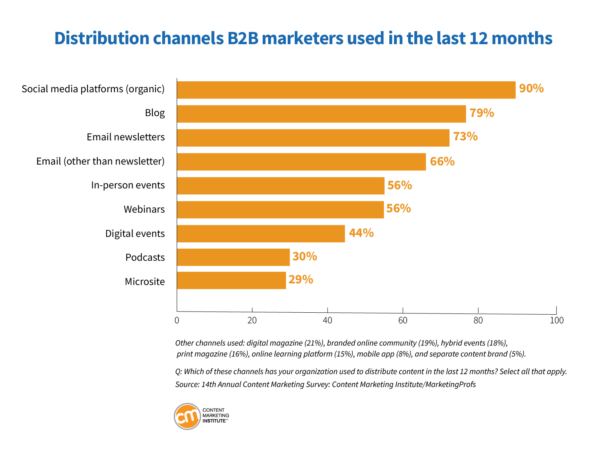
Content distribution channels used by B2B marketers
This data is not surprising since many people still prefer to receive information through their emails and check them frequently throughout the day. With email marketing automation tools, it's become easier for businesses to send targeted emails to their subscribers.
The kind of content you share through email depends on your campaigns. For example, you may send a newsletter to your subscribers with the latest company updates or industry news. Similarly, sales emails may include product promotions or discounts. You can also send informational and educational content through email, such as eBooks.
16. Over 40% of B2B marketers say email produces the best results
The Content Marketing Institute report further showed that B2B marketers see excellent results with email. According to 44% of respondents, emails other than newsletters produce the best results for them. Meanwhile, 39% of marketers saw the best results with email newsletters.
So, it's quite obvious that the effectiveness of email as a content distribution channel cannot be ignored. Marketers keep using it time and again because it produces the best results for them.
17. Email marketing ads are the second most influential type of ads
Marketers are not only using organic emails. They're also running email marketing ads to reach a wider audience. A report found that 43% of marketers find email marketing ads to be the most influential type of advertising, second only to ads through video streaming services and television.

Most influential types of ads
Email marketing ads were found to be more influential than sponsored social media content, direct mail ads, digital audio ads, and paid online search results or banner ads. There are many ways to run email marketing ads.
You can include an ad banner in your regular newsletters or send dedicated emails solely to promote your products or services. Check out our email marketing campaign examples to find inspiration for your ad campaign.
18. Email marketing is the second most effective channel for attracting leads for B2B marketers
According to Sage Frog's report, email marketing is the second most effective channel for attracting leads among B2B marketers. Over 32% of marketers report it to be effective compared to 33% who say in-person tradeshows and events do the job. So, there's not much of a difference.
In the same survey, 20% of marketers also said that email marketing is the top area of marketing spend at their organization. So, it's clear that email marketing is a key strategy for many businesses. It's not just about sending out promotional emails but also about building relationships and engaging with customers through personalized content.
Many marketers also reported using AI for their email marketing campaigns. The overall sentiment around AI use in email marketing is also quite positive. The report found that 33% of marketers are somewhat optimistic, while 25% are very optimistic about the technology's use.
19. 31% of B2B marketers use partner emails
Partner emails are emails that are sent out to an organization's partners, affiliates, or any other business connections. These emails are effective as they reach a targeted audience who already has some level of trust in the sender.
The Content Marketing Institute found that 29% of marketers use partner emails as a paid content channel. They use emails to promote their content, such as whitepapers, eBooks, case studies, and webinars. The same report also revealed that 36% of marketers find partner emails to produce the best results for their paid content strategy. It makes sense why they keep going back to this channel.
Partner emails also tend to have a higher open rate than regular emails. Why? Because the recipients are already familiar with the sender and are more likely to open an email from a trusted
20. Fewer B2B marketers have a content marketing strategy in place
While emails might be shorter than your typical long-form blog post, it still forms an integral part of content marketing. Yet, a survey completed in the middle of 2022 has revealed that only 40% of B2B marketers have admitted that they have a documented content marketing strategy in place.
21. Nearly 70% of marketers use email marketing software
Marketers use a host of tools, including email marketing software platforms. The Content Marketing Institute found that 69% of marketers use email marketing software as part of their overall marketing efforts. Email marketing tools are the third most used platforms, after analytics tools, used by 81% of marketers, and social media posting tools, used by 72% of them.
Email marketing software help automate a ton of tasks, such as segmenting email lists, sending out emails, tracking performance metrics, and personalizing emails. They can help save marketers time and money.
For example, Mailchimp lets you streamline omnichannel marketing, create beautiful email designs, automate email campaigns, write subject lines, and predict demographics. Similarly, you can use analytics tools to get reports of email campaign performance. The options are limitless.
B2B Buyer Statistics
22. Nearly half of B2B buyers email their order
Email isn’t just used by B2B organizations, but also by their buyers. A survey completed revealed that 45% of B2B buyers email their order. On the other hand only 36% prefer to place orders telephonically.

Most used purchase channels
23. 41% of B2B buyers use email for purchasing decisions
According to MarketingCharts, B2B buyers read 13 content pieces before they make any purchasing decisions. While content plays a key role in the B2B buyer journey, emails don’t feature high up on that list.
Most buyers (70%) looking to invest in marketing tech specifically find that the vendor’s website is the primary source of content. On the other hand, only 41% sourced content from the emails that were sent to them. Third-party sources like internet search, social media, and publications all proved to be more popular than email.
24. Most B2B buyers are comfortable with brand purchase history to be used
In order to incorporate marketing personalization, you need to have access to your subscribers’ data, though. Of late, data collection has received a lot of attention and with the right reason.
A survey completed in 2022 found that 82% of B2B buyers believe that it’s appropriate for marketers to collect their brand purchase history. Info on their important life events was another example of data that most B2B buyers are fine with being collected.
25. Over 60% of B2B buyers and consumers feel overwhelmed by brand communication
While it's okay to send periodic emails to your subscribers, you shouldn't be bombarding them with emails every day. Gartner reports that 64% of consumers and B2B buyers feel overwhelmed by brand communications.
That's bound to happen when you're sending too many emails, irrelevant content, or failing to personalize your messages. When subscribers feel overwhelmed, they could stop reading your emails altogether or, worse, unsubscribe from your list. You can avoid this by sending about 2 to 3 emails per week. It also helps to A/B test your email sending frequency to see what works best for your audience.
26. B2B buyers set up junk email mailboxes to avoid unwanted emails
In the same Gartner report, researchers also found that 67% of B2B buyers set up junk email mailboxes to avoid unwanted emails. This means that even if your subscribers don't unsubscribe from your list, they may not be seeing your emails at all.
Either way, it's a loss for your email marketing efforts. If you stick to a less frequent but more relevant email schedule, you can improve the email open rate and lower the unsubscribe rate.
27. Over 10% of consumers enjoy email marketing ads
Previously, we mentioned that many marketers find email marketing ads to be influential. However, when it comes to the consumer side, only 10% of them find these ads enjoyable. It's understandable, though. Email ads are usually not media-rich like social media advertisements or display ads. Plus, people often associate emails with work or personal communication, not advertising.

Most enjoyable types of ads
In contrast, 27% of consumers enjoy TV and video streaming ads. Similarly, 20% like direct mail ads, while 19% enjoy printed media ads. If you want to run email ads, maybe you can combine them with one of these mediums to amp up the engagement.
B2B Email Marketing Investment Statistics
28. Over 50% of B2B marketers increased their email marketing budget
In the same Sequel report we discussed in the previous section, it's mentioned that 55% of marketers have increased their email marketing budget in the last 12 months, while 34% plan to do so in the future. The increase in marketing budget is only second to direct mail, which has seen a budget spike of 61%.
Since B2B marketers are increasing their email marketing spending, we can assume that they're seeing results from their existing strategies. That's why they're willing to put more money into this tactic.
29. Marketing and sales departments benefit the most from promotional email elements
It's no surprise that some departments benefit more than others from email marketing. A report found that sales and marketing departments reap the most benefits from promotional email elements compared to departments like public relations and customer support.

Departments benefiting the most from promotional emails
While 39% of business leaders report sales department benefits, only 38% say the same for marketing. Other departments, like customer support, are mentioned only by 12% of leaders.
30. The majority of US B2B companies allocate only 5% to marketing
What might come as a shock is that most B2B companies in the United States don’t spend a lot on marketing activities. About a third allocated only 5% of their budgets to marketing activities. What’s more, about 23% dedicated only 1% or less.
On the opposite end of the spectrum, 26% allocated 15% or more of the budget to marketing efforts.
31. Most companies with over 500 employees use AI in email marketing
Marketing Dive found that 57% of companies with more than 500 employees use AI in email campaigns. This figure is over double the 26% who reported doing the same in 2022 in an Ascend survey. Interestingly, 25% of companies plan to use AI for email marketing in the future.
Todd Lebo, CEO at Ascend2, reports,
''Marketers are realizing there are so many channels that are out of their control. With email, the ability to control your audience is much more profound, and AI will help personalize, target, and retarget those messages much more effectively.''
His reasoning is in line with the use cases companies reported for using AI.
In the report, 50% of marketers said they use AI for content personalization, 47% use it for retargeting, 47% use it to optimize subject lines, and 44% use AI for dynamic content generation. So, there's quite a lot AI can help companies accomplish in terms of email marketing.
32. Most B2B organizations are likely to invest in content management technology
The Content Marketing Institute report we cited earlier found that 30% of B2B marketers have content marketing technology, but they aren't using it to its full potential. On the other hand, 29% have not yet acquired the right tech for their content marketing needs.
Overall, 45% of B2B marketers said that they expect to spend more on content management technology in the future. So, we can expect the enterprise content management market to grow in the coming years.

B2B marketers and content marketing tech
B2B Email Marketing Metrics Statistics
33. Over 70% of marketers use email engagement to assess content performance
B2B marketers use multiple metrics to measure content performance, such as website engagement, search rankings, conversions, and social media analytics. However, 71% of marketers use email engagement to assess content performance, second only to conversions used by 73% of marketers. It means that email engagement is a hallmark of content's impact on the audience.

Metrics used by B2B marketers
34. Over 30% marketers track email subscribers to measure content performance
When evaluating content performance, 32% of marketers track email subscribers. After all, people only subscribe to emails when they find the content useful. So, it's safe to consider email subscribers as an indicator of quality content.
35. The best time to send B2B emails is between 9 AM and 12 PM
HubSpot analyzed different email sending times and found that the best time to send B2B emails is between 9 AM and 12 PM or 12 PM and 3 PM.
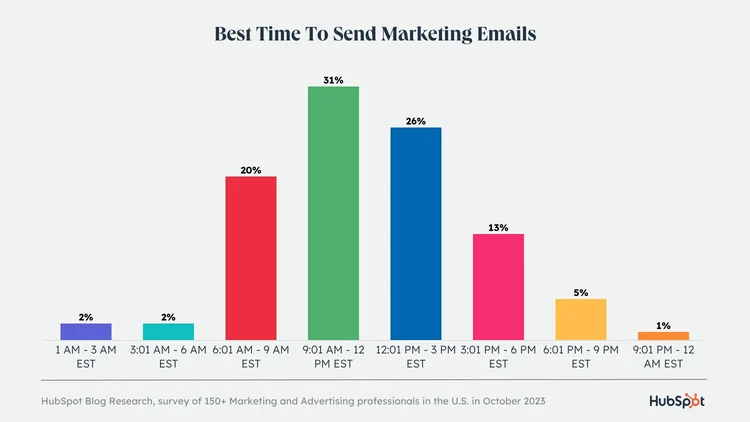
Best time to send marketing emails
When it comes to the best days, Tuesdays seem to bring the highest email open rate, followed by Mondays and Thursdays. The weekends are the worst days to send emails, which is understandable as most people are not checking their work emails on weekends.
36. Half of marketing professional perceive email channel spending to be "extremely effective"
According to Sopro's State of Prospecting report, 59% of marketers believe that email is 2x as effective as paid social media and PPC at generating leads. The same report also found that 77% of B2B buyers want to be contacted by email, which is double that of any other channel.
Similarly, Nielsen also found that half of marketing professionals rate email channel spending as "extremely effective," which was higher than 48% who voted for native advertising and 45% who selected podcasts. Marketers across the board continue to perceive email marketing as an effective channel for reaching and engaging customers.
B2B Email Marketing Challenges Statistics
37. Messaging is a major struggle
Messaging is foundational to email marketing campaigns, which makes the following stat quite alarming. The vast majority of B2B marketing decision-makers feel that their messaging strategy is ineffective. Only 8% feel that it was very effective. On the other hand, more than 30% feel that it was in need of significant improvement, while about 15% described it as ineffective.
Some of the main communication challenges experienced by B2B marketing professionals in the United States are:
- Lacking knowledge about which digital marketing techniques would be more effective for driving growth
- Difficulty digitalizing the sales process
- Lacking the skills needed to create a strong buyer’s journey online
38. Nearly half the emails go to spam
Statista reports that over 45% of emails go to spam. That’s bad news for B2B marketers because it means their emails are not reaching their intended audience. AI marketing tools can help marketers optimize subject lines, content, and targeting to increase the chances of email delivery and engagement.
39. Email campaign building and design are two main issues faced by marketers
Litmus reports that marketers face a host of issues when building email campaigns, but the two main issues are campaign building and email design. If they get these two right, the chances of their emails reaching the inbox increase substantially.
40. People barely spend 10 second reading brand emails
Even though people open brand emails, they barely spend 10 seconds reading them.
That’s not a lot of time to make an impression and convince someone to take action. Personalization is imperative to get past this issue. If the email is personalized and tailored to the recipient’s interests or needs, they are more likely to spend more than 10 seconds reading it.
41. Consumers unsubscribe if they get too many emails
We've already covered it earlier; if you send too many emails, people are likely to set up a junk filter or unsubscribe from your list. Zero Bounce reports that 44% of people cite getting too many emails as the primary reason for unsubscribing from an email list. You can't get away with not offering an unsubscribe option in your emails because if you do that, 49% of people will submit a spam complaint.
So, you should keep an optimal balance when sending out emails. Make sure your emails deliver value and are sent in a timely manner rather than overwhelming your subscribers with excessive email blasts.
Wrapping Up
These B2B email marketing statistics indicate that email marketing is still a valuable strategy for businesses. More and more marketers are increasing their email marketing spending, and the majority find it valuable with the best outcomes.
You can gain quite a lot of insights from this list. From email marketing trends and strategies to avoiding common mistakes and optimizing your emails for better engagement, these statistics can help guide your email marketing efforts.
Frequently Asked Questions
Who is targeted in B2B email marketing?
B2B buyers, such as business owners and decision-makers who are responsible for purchasing products or services on behalf of their organization, are targeted in B2B email marketing.
What is the role of email marketing in B2B?
B2B email marketing helps businesses promote their products or services to other businesses. Besides bringing in new leads, it also helps nurture relationships with existing subscribers and ultimately convert them into customers.
How long should a B2B email be?
B2B emails should be kept short and concise, typically around 50-125 words. Since people only spend a few seconds on branded emails, the message should be easily digestible for busy professionals.
How effective is email marketing in B2B?
Email marketing is quite effective in the B2B space, which is why half of B2B marketers deem their email marketing spending as extremely effective.
What is the best time to send B2B emails?
The best time to send B2B emails is between 9 AM and 12 AM or 12 AM and 3 PM.
How do I grow a B2B email list?
You can grow your B2B list by creating high-value gated content, adding opt-in forms to your blog posts, using lead-generation ads, and promoting your email sign-up on social media platforms.
What is the response rate for B2B email marketing?
On average, a good B2B email marketing response rate is around 10%. It may be higher or lower based on your industry and the quality of your email content.
How often should you send B2B marketing emails?
While there's no perfect answer, you should send B2B marketing emails at least once a month to avoid being forgotten and not more than 1-2 times a week to avoid overwhelming your subscribers.
What is the future of B2B email marketing?
B2B email marketing trends show that emails will be more automated in the future. There will be more videos and interactive elements in emails, making them more personalized and engaging for the recipients. AI tools will also be used to optimize email content and create graphics or images for emails.
How to make B2B emails more engaging?
Here are some ways to make B2B emails more engaging:
- Using personalized subject lines
- Including interactive elements like surveys and polls
- Adding images or graphics to emails
- Using A/B testing to determine the best email content and sending times
- Sending segmented emails to cater to the specific interests of different subscribers
- Including a compelling call to action in each email

